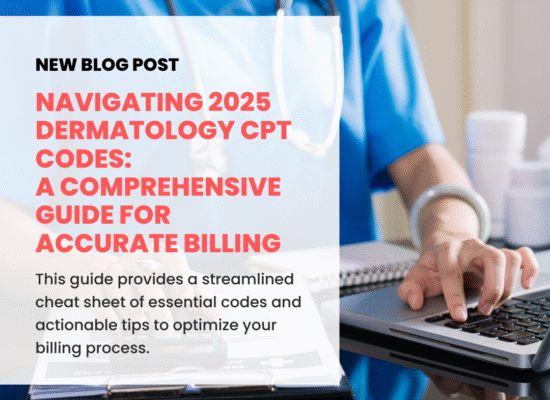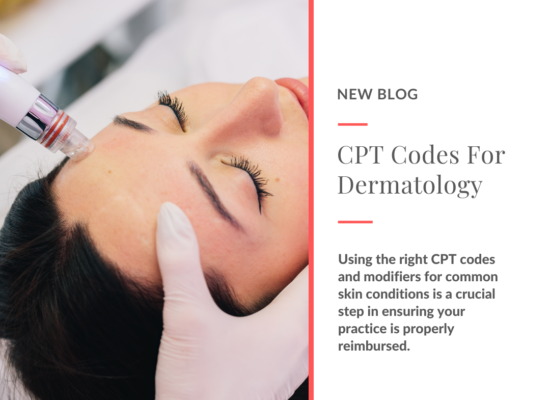The practice of dermatology is as diverse as the number of people we serve, perhaps even more so! Dealing with infants, children, teens, and every age through to the senior years, the range of skin conditions and/or health issues that a person may encounter during their lifetime is staggering and that’s without taking into account persons who may just be looking for treatment options that are for purely cosmetic reasons. We know we don’t have to tell you this – and no doubt you also know the variety of CPT dermatology billing codes associated with billing for these treatments. But we have to ask – do you know codes like we know codes?
First, we should start by clarifying CPT refers to Current Procedural Technology and is used throughout the medical community to classify every type of procedure under every discipline. The insurance and billing landscape, not to mention the AMA (American Medical Association) is ever-changing and can be difficult for anyone to manage, even skilled dermatology practitioners and their staff. In 2021 alone, over 329 CPT code changes occurred across the entire medical spectrum with at least 10 of those changes related directly to dermatology billing. Currently, ICD-10, the benchmark for CPT coding, lists the following codes as the “Top 10 Most Commonly Used,” but no doubt, even this list will change again soon enough! Do any of these CPT codes sound familiar? And what’s the best way to stay up to date with all the changes?
Top 10 Commonly Used CPT Dermatology Codes
B07.0 – Plantar wart
B07.9 – Viral wart, unspecified
B35.3 – Tinea pedis
B35.4 – Tinea corporis
B35.5 – Tinea imbricata
C43.31 – Malignant melanoma of the nose
C44.01 – Basal cell carcinoma of skin of the lip
D03.30 – Melanoma in situ of unspecified part of the face
D48.5 – Neoplasm of uncertain behavior of skin
I83.10 – Varicose veins of unspecified lower extremity
Even if these codes don’t sound familiar, we know you are familiar with the treatments because coding and treatments go hand in hand. You’re identifying and dealing with more of these “Top Ten” skin conditions than any other condition, with psoriasis, freckles and seborrheic keratosis not lagging too far behind. Treating these skin conditions is one thing, billing for them is quite another. That’s one of the reasons Derm Care Billing Consultants exists – because we know a thing or two about CPT dermatology billing codes and this list is just a small sampling of the sheer volume of codes that must be used when billing for dermatology claims. In addition to codes for identification of skin concerns there are also codes that are dependent upon method of diagnosis, method of treatment (for example, Mohs coding), or even whether a procedure is a straightforward medical one, or a more complicated surgical procedure.
Adding even more to the complicated process of billing insurance companies for treatments completed – there are “modifiers.” These are codes specifically used to modify the original treatment codes and are based on a particular set of circumstances. For example, Modifier 25 can only be used for existing patients who have a record of treatment at your practice, not for new patients while Modifier 59 is used to separate a service or procedure as distinct from others performed on the same patient that same day. Medicare also now uses “X” modifiers which can be used in place of the 59 modifier, but we’re pretty sure at this point – you get the point we’re trying to make – that dermatology billing codes are difficult, challenging and a great deal of work. You have enough to do from treating patients to managing your staff team. So let us handle the medical billing.
Using coding experts, like the team at Derm Care, is one way to guarantee you’ll receive proper payment for your services, as they will all be coded accurately. It will see your claims denial rate go down significantly. This will result in fewer call-backs to your patients requesting payments or deductibles, and less of having to try to collect on denied claims. Less staff dissatisfaction is practically guaranteed. If you want to try and stay ahead of claims on your own – consider creating a list for office staff that contains not only the Top – 10 ICD Codes as we’ve included here but perhaps the Top – 25 or even 50. This would become your relied upon “cheat sheet” of sorts, a handy reference tool for anyone assigned the task of working together with insurance companies to have claims paid. You may want to include on this cheat sheet a fulsome explanation of the most commonly used “modifiers” in your office – modifiers that may vary depending upon the type of services you most typically offer. All coding would be separate and distinct from any cosmetic services you provide which are typically billed directly to the patient, adding another layer of complexity to your billing processes.
You would be forgiven for thinking this all sounds kind of complicated. That’s because it can be when it’s not something you specialize in. We would never presume to treat a plantar wart but we do know the code is B07.0 and how to bill for the services YOU perform. You’re already a subject matter expert and so are we. Let’s work together to ensure a billing process that’s as smooth as clearing up a bad case of L25.0. (If you know, you know!)






2 thoughts on “Staying Up to Date in Dermatology Billing”
Comments are closed.